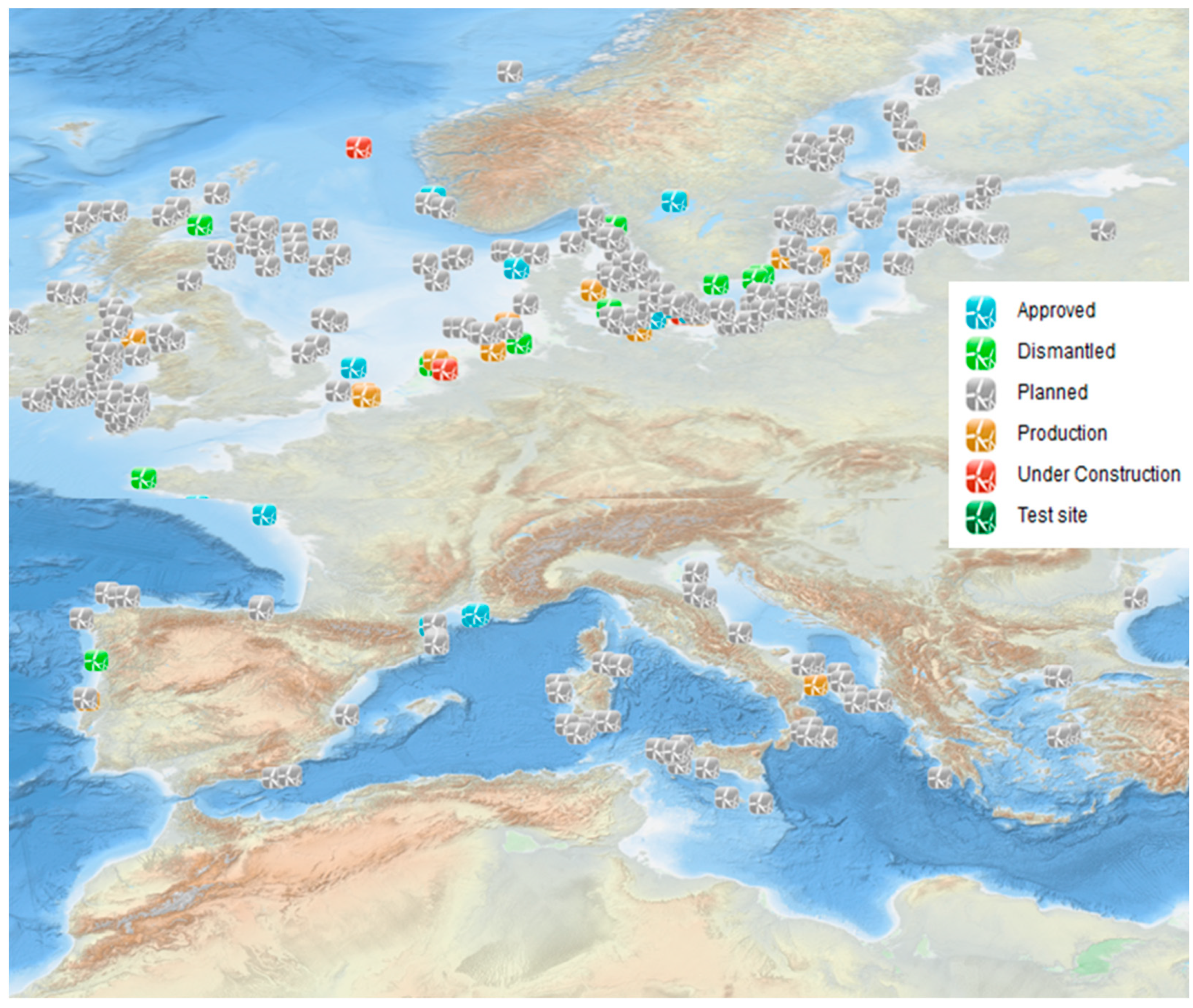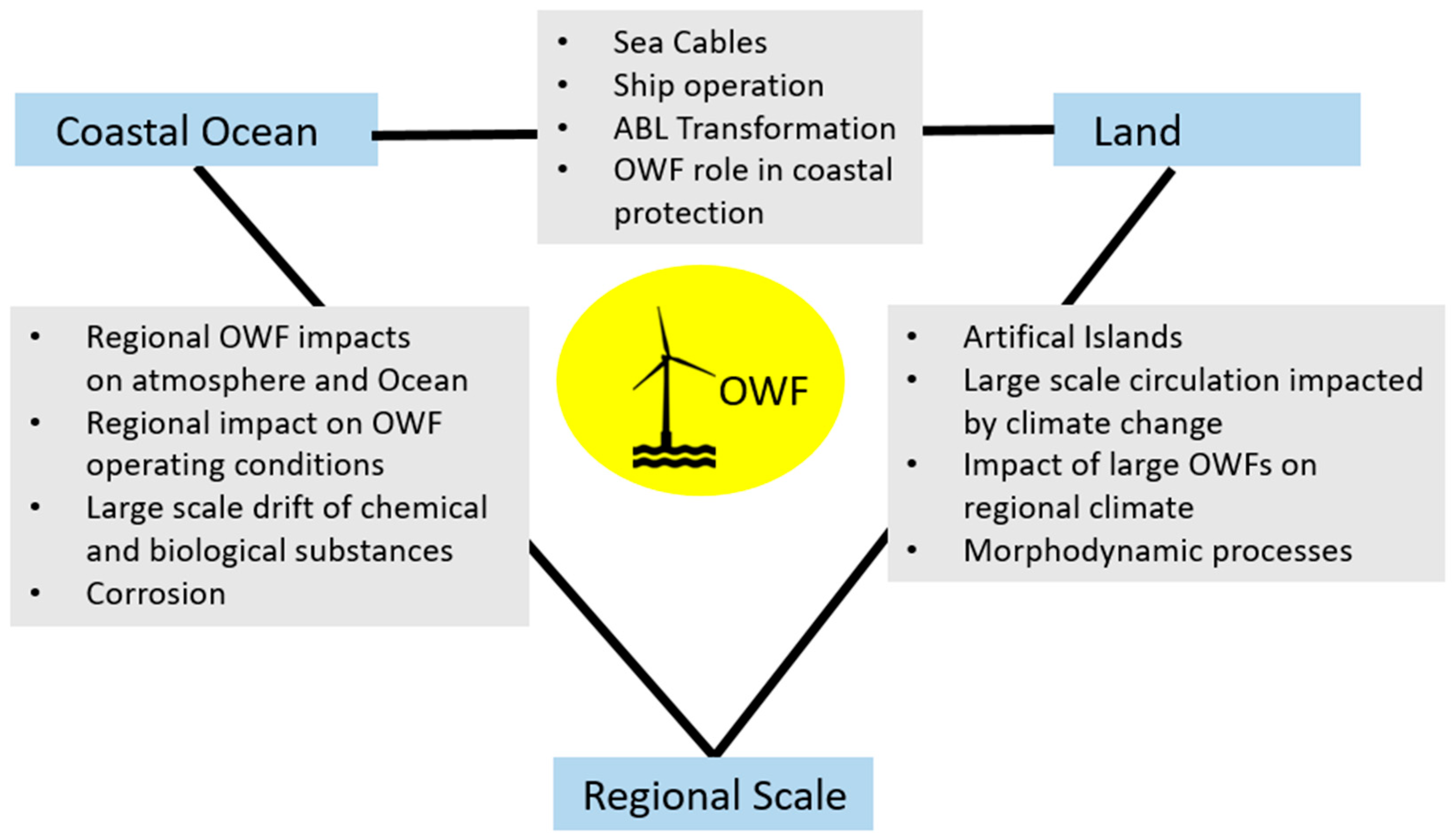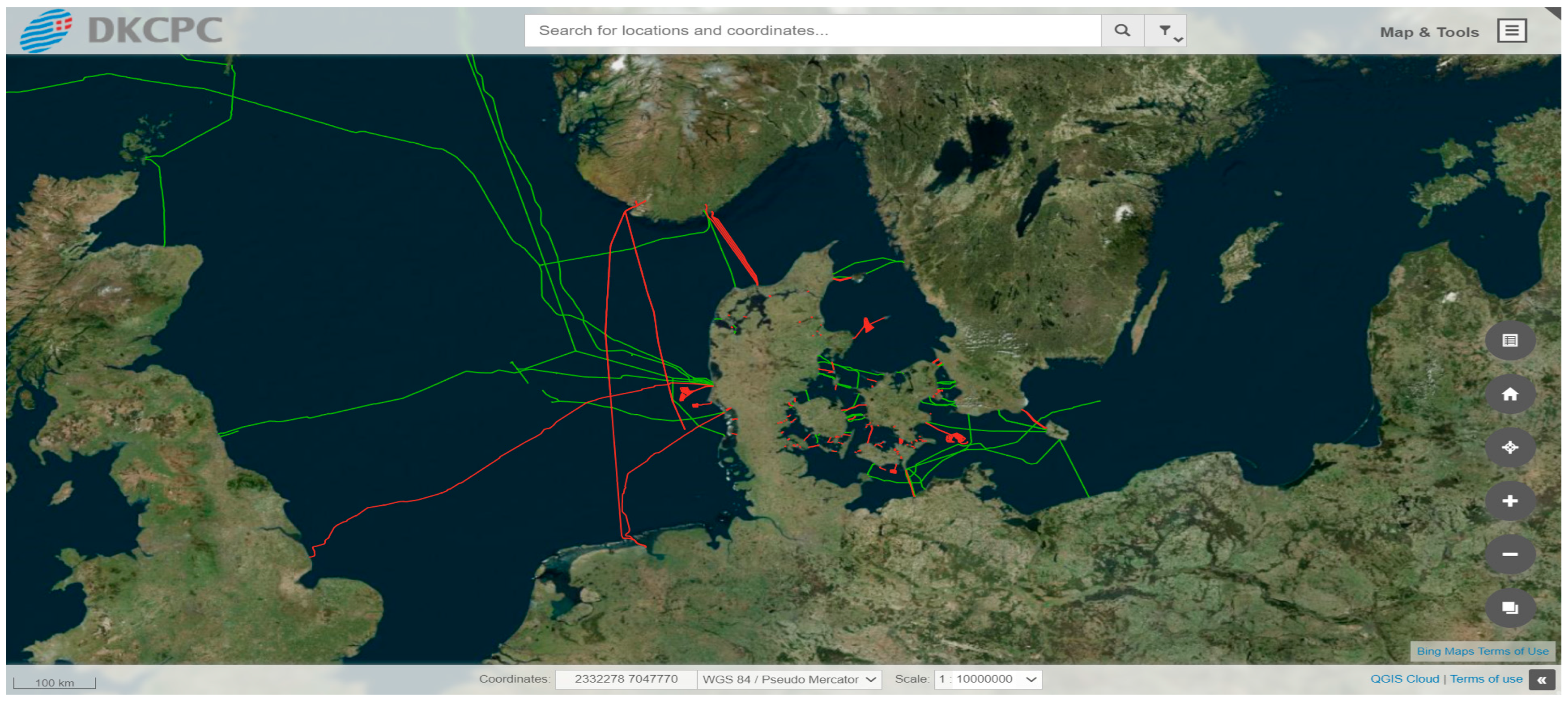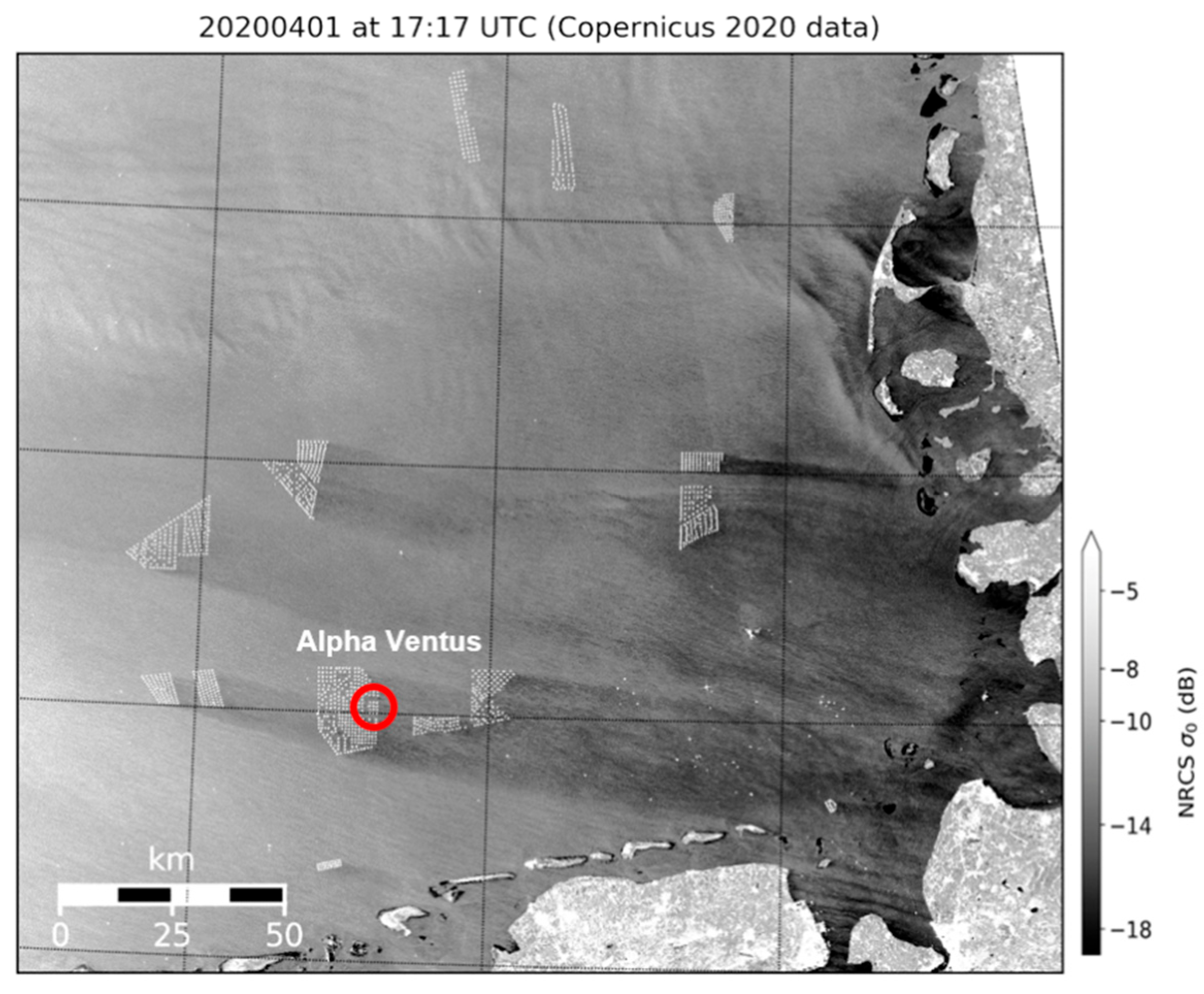Fit-for-Purpose Information for Offshore Wind Farming Applications—Part-I: Identification of Needs and Solutions
Abstract
:1. Introduction
1.1. Offshore Wind Farm and Connectivity: Significance and Complexity
- Most OWFs are located in the transition zone between the oceanic and land atmospheric boundary layer [6], where a complex transformation process (including the formation of an intermediate boundary layer (IBL)) takes place, which is conditioned by different ocean processes, e.g., ocean waves and water temperatures.
- OWFs are known to potentially add to the connectivity between different ecological habitats by serving as a habitat themselves. The fact that OWF areas are declared as no-fishing zones plays an important role in this context as well.
- With the growing number and size of OWF installations, the respective impacts on the environment will take place on larger scales and thus contribute to regional connectivity. This concerns the release and drift of substances as much as the impacts on momentum and heat fluxes between the ocean and the atmosphere.
- Sea cables are required to connect OWFs to land, and this comes with several challenges, e.g., related to morphodynamic processes or heating of the sea floor.
- Artificial islands are a recent development leading to new requirements concerning observations and modeling.
1.2. Observation Requirements and Gap Analysis for OWF
2. Methodology
2.1. Step 1: User Requirements for Key Information Products
2.2. Step 2: Identifying Potential Solutions Based on Integrated Monitoring–Modeling Approach
2.3. Step 3: Identifying Requirements for Using Observations and Improving Models
3. Application Areas, Challenges, and Required Information Products
3.1. OWF Operation and Maintenance
- Ship operations for OWF maintenance.
- OWF fatigue assessments are needed for lifetime extensions.
3.2. Protection of Submarine Cables
3.3. Wake and Lee Effects
3.4. Impacts of OWF on Transport, Maritime Safety, and Weather Forecasting
3.5. Contamination Assessment and Response
3.6. Ecological Impacts of OWFs
4. Solutions and Required Data and Modeling Technologies
4.1. OWF Operation and Maintenance
- The impact of OWFs on winds and waves is currently not resolved by weather and wave forecasts.
- Wave propagation and dissipation terms in shallow waters and areas with land–sea blended grids require specific treatment [61]. Complex coastlines, including islands, will change wave propagation, but the model resolution is insufficient.
- Interaction between waves and currents must be resolvedas the sea level becomes significant in coastal waters.
4.2. Protection of Submarine Cables
4.3. Wake and Lee Effects
4.4. Specific Impacts of OWF on Sea Ice and Safety
4.5. Contamination Assessment and Response
4.6. Ecological Impacts
5. Discussion
5.1. Multi-Use of OWF Platforms
5.2. Model-Observation Integration in Areas with High Connectivity and Multiple Scales
5.3. Coordinated Data Management for OWF Applications
5.4. Data Transmission, Interoperability, and Accessibility
6. Conclusions
Supplementary Materials
Author Contributions
Funding
Institutional Review Board Statement
Informed Consent Statement
Data Availability Statement
Acknowledgments
Conflicts of Interest
Appendix A. Required Observations for OWF Applications with High Connectivity
| Application Area & Information Product | Purpose of Using Observations | Variables | Spatial Needs | Temporal Needs |
|---|---|---|---|---|
| O&M: Forecast and related uncertainties of waves, sea ice, sea level, currents and icing | Model parameterization, cal/val, model-data integration for optimal forecast | Waves Surface winds Surface currents Sea ice properties Icing, humidity, etc. | A few sites per OWF and connectivity area | Hourly daily, real-time |
| O&M: Long-term and extreme load | fatigue/extreme load estimation | Waves | A few sites per OWF | Hourly, lifetime |
| Sea ice | OWF area | Daily, lifetime | ||
| Sea bed cable protection: Shear stress, sediment layer thickness above cable for cable protection | Inputs to model | Bathymetry | Model area | Static |
| Sea bed substrate | Model area | Static | ||
| Riverine SPM discharge | Model area | Daily or hourly | ||
| Model cal/val, parameterization, process study | Waves | Cable area | Hourly | |
| SPM concentration | Model area | hourly or daily | ||
| Sedimentation rate | Model area | Static | ||
| Sea bed sediment (size, layer thickness) | Cable area | Monthly or quarterly | ||
| Wake/lee effects: Weather–ocean–wave–ice–SPM forecast with impacts of OWFs | Calibrating and validating models; optimal forecast by integrating local observations and model forecast | Wind/current profiles, surface wave spectra | One site per OWF | Hourly for two periods before/after OWF deployment; or for a dedicated campaign period. |
| ABL variables, waves, T, S | A few sites per OWF | |||
| Surface currents | A few sites per farm, 2D distribution | |||
| Shoreline positions | Coastal stretch, OWF downstream | |||
| Sea ice | A few sites per OWF and model area | Hourly daily | ||
| Security and marine forecasting: Impacts of OWF on radar signal propagation | Fill the spatial data gaps due to shadowing effects | Precipitation, winds, radar targets | 3-dimensional | Hourly |
| Contamination: 3D distribution of metal and chemical contaminant concentrations | Calibrate models, data assimilation, impact assessment | Concentration of Al, Zn, Cd, In, BBA, etc.; surface currents | Seawater, sediment, biota, both on-site and in surrounding areas | Long-term, seasonal or annual sampling |
| Ecological impacts: Changes in abiotic conditions, leading to changes in biota | Trend detection, analysis of cause–effect relations, model validation | Noise, bed topography and composition, vertical profiles of T, S, turbidity, light, population densities of biota: phytoplankton, zooplankton, benthos, fish, marine mammals, birds | In OWFs and their lee area, vertical profiles of pelagic variables | Long-term consistent for trend detection, high temporal resolution for representativeness and detecting interactions between variables |
References
- WindEurope. Our Energy, Our Future—How Offshore Wind Will Help Europe Go Carbon-Neutral? Colin, W., Ed.; WindEurope: Brussels, Belgium, 2019; Available online: https://www.windenergy.org (accessed on 10 August 2023).
- Tikanmäki, M.; Heinonen, J. Estimating extreme level ice and ridge thickness for offshore wind turbine design: Case study Kriegers Flak. Wind. Energy 2022, 25, 639–659. [Google Scholar] [CrossRef]
- Van der Molen, J.; García-García, L.M.; Whomersley, P.; Callaway, A.; Posen, P.E.; Hyder, K. Connectivity of larval stages of sedentary marine communities between hard substrates and offshore structures in the North Sea. Sci. Rep. 2018, 8, 14772. [Google Scholar] [CrossRef] [PubMed]
- Jaspers, C.; Huwer, B.; Antajan, E.; Hosia, A.; Hinrichsen, H.-H.; Biastoch, A.; Angel, D.; Asmus, R.; Augustin, C.; Bagheri, S.; et al. Ocean current connectivity propelling the secondary spread of a marine invasive comb jelly across western Eurasia. Glob. Ecol. Biogeogr. 2018, 27, 814–827. [Google Scholar] [CrossRef]
- Hinrichsen, H.-H.; Piatkowski, U.; Jaspers, C. Sightings of extraordinary marine species in the SW Baltic Sea linked to saline water inflows. J. Sea Res. 2022, 181, 102175. [Google Scholar] [CrossRef]
- Schulz-Stellenfleth, J.; Emeis, S.; Dörenkämper, M.; Bange, J.; Cañadillas, B.; Neumann, T.; Schneemann, J.; Weber, I.; Berge, K.Z.; Platis, A.; et al. Coastal impacts on offshore wind farms—A review focussing on the German Bight area. Meteorol. Z. 2022, 31, 289–315. [Google Scholar] [CrossRef]
- The Crown Estate; The Offshore Renewable Energy Catapult. Guide to an Offshore Wind Farm; BVG Associates Limited: Swindon, UK, 2019; p. 128. [Google Scholar]
- Baschek, B.; Schroeder, F.; Brix, H.; Riethmüller, R.; Badewien, T.H.; Breitbach, G.; Brügge, B.; Colijn, F.; Doerffer, R.; Eschenbach, C.; et al. The Coastal Observing System for Northern and Arctic Seas (COSYNA). Ocean Sci. 2017, 13, 379–410. [Google Scholar] [CrossRef]
- Sendra, S.; Parra, L.; Jimenez, J.M.; Garcia, L.; Lloret, J. LoRa-based Network for Water Quality Monitoring in Coastal Areas. Mob. Networks Appl. 2022, 27, 1–17. [Google Scholar] [CrossRef]
- Wu, T.-D.; Chen, Z.-J.; Chang, C.-C.; Wang, H.-F. Design of a Wireless Sensor Network for Open Ocean Aquaculture Based on 802.11 ac Wireless Bridge and LoRa™ Technology. In Proceedings of the International Workshop on Electromagnetics: Applications and Student Innovation Competition (iWEM), Makung, Taiwan, 26–28 August 2020; pp. 1–2. [Google Scholar] [CrossRef]
- Martinez-Luengo, M.; Kolios, A.; Wang, L. Structural health monitoring of offshore wind turbines: A review through the Statistical Pattern Recognition Paradigm. Renew. Sustain. Energy Rev. 2016, 64, 91–105. [Google Scholar] [CrossRef]
- Míguez, B.M.; Novellino, A.; Vinci, M.; Claus, S.; Calewaert, J.-B.; Vallius, H.; Schmitt, T.; Pititto, A.; Giorgetti, A.; Askew, N.; et al. The European Marine Observation and Data Network (EMODnet): Visions and Roles of the Gateway to Marine Data in Europe. Front. Mar. Sci. 2019, 6, 313. [Google Scholar] [CrossRef]
- She, J.; Murawski, J. Developing community marine data service for Blue Growth sectors. J. Oper. Oceanogr. 2019, 12 (Suppl. S2), S80–S96. [Google Scholar] [CrossRef]
- Stephenson, P.J. A Review of Biodiversity Data Needs and Monitoring Protocols for the Offshore Wind Energy Sector in the Baltic Sea and North Sea; Report for the Renewables Grid Initiative; Renewables Grid Initiative: Berlin, Germany, 2021. [Google Scholar]
- Natural Resources Defence Council. Monitoring of Marine Life during Offshore Wind Energy Development—Guidelines and Recommendations. NRDC Report. 2023. Available online: https://www.nrdc.org/sites/default/files/ow_marine-life_monitoring_guidelines.pdf (accessed on 10 August 2023).
- Abhinav, K.; Collu, M.; Benjamins, S.; Cai, H.; Hughes, A.; Jiang, B.; Jude, S.; Leithead, W.; Lin, C.; Liu, H.; et al. Offshore multi-purpose platforms for a Blue Growth: A technological, environmental and socio-economic review. Sci. Total Environ. 2020, 734, 138256. [Google Scholar] [CrossRef] [PubMed]
- Floeter, J.; van Beusekom, J.E.; Auch, D.; Callies, U.; Carpenter, J.; Dudeck, T.; Eberle, S.; Eckhardt, A.; Gloe, D.; Hänselmann, K.; et al. Pelagic effects of offshore wind farm foundations in the stratified North Sea. Prog. Oceanogr. 2017, 156, 154–173. [Google Scholar] [CrossRef]
- Vedel, H.; Fischereit, J.; Kaas, E. Including the Effect of Wind Turbines in the Harmonie NWP and Climate Models; Danish Meteorological Institute (DMI) Report 22-19; Danish Meteorological Institute: Copenhagen, Denmark, 2022; ISSN 2445-9127. ISBN 978-87-7478-720-4. [Google Scholar]
- Carpenter, J.R.; Merckelbach, L.; Callies, U.; Clark, S.; Gaslikova, L.; Baschek, B. Potential Impacts of Offshore Wind Farms on North Sea Stratification. PLoS ONE 2016, 11, e0160830. [Google Scholar] [CrossRef]
- Schultze, L.K.P.; Merckelbach, L.M.; Horstmann, J.; Raasch, S.; Carpenter, J.R. Increased Mixing and Turbulence in the Wake of Offshore Wind Farm Foundations. J. Geophys. Res. Oceans 2020, 125, e2019JC015858. [Google Scholar] [CrossRef]
- Taormina, B.; Bald, J.; Want, A.; Thouzeau, G.; Lejart, M.; Desroy, N.; Carlier, A. A review of potential impacts of submarine power cables on the marine environment: Knowledge gaps, recommendations and future directions. Renew. Sustain. Energy Rev. 2018, 96, 380–391. [Google Scholar] [CrossRef]
- Cao, C.; Ge, Y.; Ren, X.; Peng, X.; Chen, J.; Lu, Z.; Zheng, X. Experimental research on submarine cable monitoring method based on MEMS sensor. Micro Nano Eng. 2022, 15, 100130. [Google Scholar] [CrossRef]
- Kirchgeorg, T.; Weinberg, I.; Hörnig, M.; Baier, R.; Schmid, M.; Brockmeyer, B. Emissions from corrosion protection systems of offshore wind farms: Evaluation of the potential impact on the marine environment. Mar. Pollut. Bull. 2018, 136, 257–268. [Google Scholar] [CrossRef]
- Farr, H.; Ruttenberg, B.; Walter, R.K.; Wang, Y.-H.; White, C. Potential environmental effects of deepwater floating offshore wind energy facilities. Ocean Coast. Manag. 2021, 207, 105611. [Google Scholar] [CrossRef]
- NASEM, National Academies of Sciences, Engineering, and Medicine. Wind Turbine Generator Impacts to Marine Vessel Radar; The National Academies Press: Washington, DC, USA, 2022. [Google Scholar] [CrossRef]
- Trockel, D.; Rodriguez-Alegre, I.; Barrick, D.; Whelan, C. Impact Assessment and Mitigation of Offshore Wind Turbines on High Frequency Coastal Oceanographic Radar; OCS Study BOEM 2018-053; US Department of the Interior, Bureau of Ocean Energy Management: Sterling, VA, USA, 2018.
- U.S. Department of Energy (DOE). 2020. Available online: https://www.energy.gov/sites/prod/files/2020/04/f74/offshore-wind-turbine-radar-interference-mitigation-webinar-4-20-2020.pdf (accessed on 10 August 2023).
- Leijnse, H.; Teschl, R.; Paulitsch, H.; Teschl, F.; Holmes, G.; Fodnes Sidselrud, L. OPERA-4: On the Coexistence of Weather Radars and Wind Turbines. 2022. Available online: https://www.eumetnet.eu/wp-content/uploads/2022/08/OPERA_wind_turbine_report_20220225.pdf (accessed on 10 August 2023).
- De Matos e Sá, M. Short-Term O&M Planning for Offshore Wind Energy. Ph.D. Thesis, KTH Royal Institute of Technology, Stockholm, Sweden, 2022. Available online: https://www.diva-portal.org/smash/get/diva2:1726974/FULLTEXT01.pdf (accessed on 10 August 2023).
- Taylor, J.W.; Jeon, J. Probabilistic forecasting of wave height for offshore wind turbine maintenance. Eur. J. Oper. Res. 2018, 267, 877–890. [Google Scholar] [CrossRef]
- Energinet. Geological Survey Report Lot2: Thor Offshore Wind Farm Export Cable Route Investigation; 103282-ENN-MMT-SUR-REP-SURVLOT2 REVISION B; MMT SWEDEN AB: Västra Frölunda, Sweden, 2020. [Google Scholar]
- Timco, G.; Burden, R. An analysis of the shapes of sea ice ridges. Cold Reg. Sci. Technol. 1997, 25, 65–77. [Google Scholar] [CrossRef]
- Brandao, I.; van der Molen, J.; van der Wal, D. Effects of offshore wind farms on suspended particulate matter derived from satellite remote sensing. Sci. Total Environ. 2023, 866, 161114. [Google Scholar] [CrossRef] [PubMed]
- Djath, B.; Schulz-Stellenfleth, J.; Cañadillas, B. Impact of atmospheric stability on X-band and C-band synthetic aperture radar imagery of offshore windpark wakes. J. Renew. Sustain. Energy 2018, 10, 043301. [Google Scholar] [CrossRef]
- Van Berkel, J.; Burchard, H.; Christensen, A.; Mortensen, L.; Petersen, O.; Thomsen, F. The Effects of Offshore Wind Farms on Hydrodynamics and Implications for Fishes. Oceanography 2020, 33, 108–117. [Google Scholar] [CrossRef]
- Rennau, H.; Schimmels, S.; Burchard, H. On the effect of structure-induced resistance and mixing on inflows into the Baltic Sea: A numerical model study. Coast. Eng. 2012, 60, 53–68. [Google Scholar] [CrossRef]
- Cazenave, P.W.; Torres, R.; Allen, J.I. Unstructured grid modelling of offshore wind farm impacts on seasonally stratified shelf seas. Prog. Oceanogr. 2016, 145, 25–41. [Google Scholar] [CrossRef]
- Christensen, E.D.; Kristensen, S.E.; Deigaard, R. Impact of an offshore wind farm on wave conditions and shoreline development. In Proceedings of the 34th International Conference on Coastal Engineering, Seoul, Republic of Korea, 15–20 June 2014. [Google Scholar]
- Vihma, T.; Haapala, J.; Matthäus, W. Geophysics of sea ice in the Baltic Sea: A review. Prog. Oceanogr. 2009, 80, 129–148. [Google Scholar] [CrossRef]
- Battisti, L.; Fedrizzi, R.; Brighenti, A.; Laakso, T. Sea ice and icing risk for offshore wind turbines. In Offshore Wind and Other Marine Renewable Energies in Mediterranean and European Seas, Proceedings of the OWEMES European Seminars, Civitavecchia, Rome, Italy, 20–22 April 2006; OWEMES Association Onlus: Rome, Italy, 2006; ISBN 978-88-8286-283-1. [Google Scholar]
- Karvonen, J. Virtual radar ice buoys—A method for measuring fine-scale sea ice drift. Cryosphere 2016, 10, 29–42. [Google Scholar] [CrossRef]
- Oikkonen, A.; Haapala, J.; Lensu, M.; Karvonen, J.; Itkin, P. Small-scale sea ice deformation during N-ICE2015: From compact pack ice to marginal ice zone. J. Geophys. Res. Oceans 2017, 122, 5105–5120. [Google Scholar] [CrossRef]
- Rautiainen, L.; Tyynelä, J.; Lensu, M.; Siiriä, S.; Vakkari, V.; O’Connor, E.; Hämäläinen, K.; Lonka, H.; Stenbäck, K.; Koistinen, J.; et al. Utö Observatory for Analysing Atmospheric Ducting Events over Baltic Coastal and Marine Waters. Remote Sens. 2023, 15, 2989. [Google Scholar] [CrossRef]
- Mangi, S.C. The Impact of Offshore Wind Farms on Marine Ecosystems: A Review Taking an Ecosystem Services Perspective. Proc. IEEE 2013, 101, 999–1009. [Google Scholar] [CrossRef]
- Simpson, S.D.; Radford, A.N.; Nedelec, S.L.; Ferrari, M.C.O.; Chivers, D.P.; McCormick, M.I.; Meekan, M.G. Anthropogenic noise increases fish mortality by predation. Nat. Commun. 2016, 7, 10544. [Google Scholar] [CrossRef] [PubMed]
- Madsen, P.; Wahlberg, M.; Tougaard, J.; Lucke, K.; Tyack, P. Wind turbine underwater noise and marine mammals: Implications of current knowledge and data needs. Mar. Ecol. Prog. Ser. 2006, 309, 279–295. [Google Scholar] [CrossRef]
- Roberts, L.; Elliott, M. Good or bad vibrations? Impacts of anthropogenic vibration on the marine epibenthos. Sci. Total Environ. 2017, 595, 255–268. [Google Scholar] [CrossRef] [PubMed]
- Edmonds, N.J.; Firmin, C.J.; Goldsmith, D.; Faulkner, R.C.; Wood, D.T. A review of crustacean sensitivity to high amplitude underwater noise: Data needs for effective risk assessment in relation to UK commercial species. Mar. Pollut. Bull. 2016, 108, 5–11. [Google Scholar] [CrossRef]
- Roberts, L.; Breithaupt, T. Sensitivity of Crustaceans to Substrate-Borne Vibration. In The Effects of Noise on Aquatic Life II; Springer: New York, NY, USA, 2016; pp. 925–931. [Google Scholar] [CrossRef]
- Jolivet, A.; Tremblay, R.; Olivier, F.; Gervaise, C.; Sonier, R.; Genard, B.; Chauvaud, L. Validation of trophic and anthropic underwater noise as settlement trigger in blue mussels. Sci. Rep. 2016, 6, srep33829. [Google Scholar] [CrossRef]
- Stanley, J.A.; Wilkens, S.; McDonald, J.I.; Jeffs, A.G. Vessel noise promotes hull fouling. In The Effects of Noise on Aquatic Life II; Springer: New York, NY, USA, 2016; pp. 1097–1104. [Google Scholar]
- Solan, M.; Hauton, C.; Godbold, J.A.; Wood, C.L.; Leighton, T.G.; White, P. Anthropogenic sources of underwater sound can modify how sediment-dwelling invertebrates mediate ecosystem properties. Sci. Rep. 2016, 6, 20540. [Google Scholar] [CrossRef]
- Methratta, E.T.; Dardick, W.R. Meta-Analysis of Finfish Abundance at Offshore Wind Farms. Rev. Fish. Sci. Aquac. 2019, 27, 242–260. [Google Scholar] [CrossRef]
- Alberta, L.; Deschamps, F.; Joliveta, A.; Olivier, F.; Chauvaud, L.; Chauvaud, S. Acurrent synthesis on the effects of electric and magnetic fields emitted by submarine power cables on invertebrates. Mar. Environ. Res. 2020, 159, 104958. [Google Scholar] [CrossRef]
- Cresci, A.; Durif, C.M.F.; Larsen, T.; Bjelland, R.; Skiftesvik, A.B.; Browman, H.I. Magnetic fields produced by subsea high-voltage direct current cables reduce swimming activity of haddock larvae (Melanogrammus aeglefinus). PNAS Nexus 2022, 1, pgac175. [Google Scholar] [CrossRef]
- Cresci, A.; Perrichon, P.; Durif, C.M.; Sørhus, E.; Johnsen, E.; Bjelland, R.; Larsen, T.; Skiftesvik, A.B.; Browman, H.I. Magnetic fields generated by the DC cables of offshore wind farms have no effect on spatial distribution or swimming behaviour of lesser sandeel larvae (Ammodytes marinus). Environ. Res. 2022, 176, 105609. [Google Scholar]
- Krijgsveld, K.L.; Akershoek, K.; Schenk, F.; Dijk, F.; Dirksen, S. Collision Risk of Birds with Modern Large Wind Turbines. Ardea 2009, 97, 357–366. [Google Scholar] [CrossRef]
- Johnston, A.; Cook, A.S.C.P.; Wright, L.J.; Humphreys, E.M.; Burton, N.H.K. Modelling flight heights of marine birds to more accurately assess collision risk with offshore wind turbines. J. Appl. Ecol. 2014, 51, 31–41. [Google Scholar] [CrossRef]
- Vanhellemont, Q.; Ruddick, K. Turbid wakes associated with offshore wind turbines observed with Landsat 8. Remote. Sens. Environ. 2014, 145, 105–115. [Google Scholar] [CrossRef]
- Bidlot, J.-R. Model Upgrade Improves Ocean Wave Forecasts. ECMWF Newsletter 159. 2019. Available online: https://www.ecmwf.int/en/newsletter/159/news/model-upgrade-improves-ocean-wave-forecasts (accessed on 10 August 2023).
- Gorrell, L.; Raubenheimer, B.; Elgar, S.; Guza, R. SWAN predictions of waves observed in shallow water onshore of complex bathymetry. Coast. Eng. 2011, 58, 510–516. [Google Scholar] [CrossRef]
- Golbeck, I.; Li, X.; Janssen, F.; Brüning, T.; Nielsen, J.W.; Huess, V.; Söderkvist, J.; Büchmann, B.; Siiriä, S.-M.; Vähä-Piikkiö, O.; et al. Uncertainty estimation for operational ocean forecast products—A multi-model ensemble for the North Sea and the Baltic Sea. Ocean Dyn. 2015, 65, 1603–1631. [Google Scholar] [CrossRef]
- Pujol, M.-I.; Dupuy, S.; Vergara, O.; Román, A.S.; Faugère, Y.; Prandi, P.; Dabat, M.-L.; Dagneaux, Q.; Lievin, M.; Cadier, E.; et al. Refining the Resolution of DUACS Along-Track Level-3 Sea Level Altimetry Products. Remote. Sens. 2023, 15, 793. [Google Scholar] [CrossRef]
- Schulz-Stellenfleth, J.; Blauw, A.; Laakso, L.; Mourre, B.; She, J.; Wehde, H. Fit-for-purpose information in coastal seas with high connectivity for offshore wind farming applications. Part-II: Gap Analysis and Recommendations. J. Mar. Sci. Eng. 2023, 11, x. [Google Scholar]





Disclaimer/Publisher’s Note: The statements, opinions and data contained in all publications are solely those of the individual author(s) and contributor(s) and not of MDPI and/or the editor(s). MDPI and/or the editor(s) disclaim responsibility for any injury to people or property resulting from any ideas, methods, instructions or products referred to in the content. |
© 2023 by the authors. Licensee MDPI, Basel, Switzerland. This article is an open access article distributed under the terms and conditions of the Creative Commons Attribution (CC BY) license (https://creativecommons.org/licenses/by/4.0/).
Share and Cite
She, J.; Blauw, A.; Laakso, L.; Mourre, B.; Schulz-Stellenfleth, J.; Wehde, H. Fit-for-Purpose Information for Offshore Wind Farming Applications—Part-I: Identification of Needs and Solutions. J. Mar. Sci. Eng. 2023, 11, 1630. https://doi.org/10.3390/jmse11081630
She J, Blauw A, Laakso L, Mourre B, Schulz-Stellenfleth J, Wehde H. Fit-for-Purpose Information for Offshore Wind Farming Applications—Part-I: Identification of Needs and Solutions. Journal of Marine Science and Engineering. 2023; 11(8):1630. https://doi.org/10.3390/jmse11081630
Chicago/Turabian StyleShe, Jun, Anouk Blauw, Lauri Laakso, Baptiste Mourre, Johannes Schulz-Stellenfleth, and Henning Wehde. 2023. "Fit-for-Purpose Information for Offshore Wind Farming Applications—Part-I: Identification of Needs and Solutions" Journal of Marine Science and Engineering 11, no. 8: 1630. https://doi.org/10.3390/jmse11081630
APA StyleShe, J., Blauw, A., Laakso, L., Mourre, B., Schulz-Stellenfleth, J., & Wehde, H. (2023). Fit-for-Purpose Information for Offshore Wind Farming Applications—Part-I: Identification of Needs and Solutions. Journal of Marine Science and Engineering, 11(8), 1630. https://doi.org/10.3390/jmse11081630








